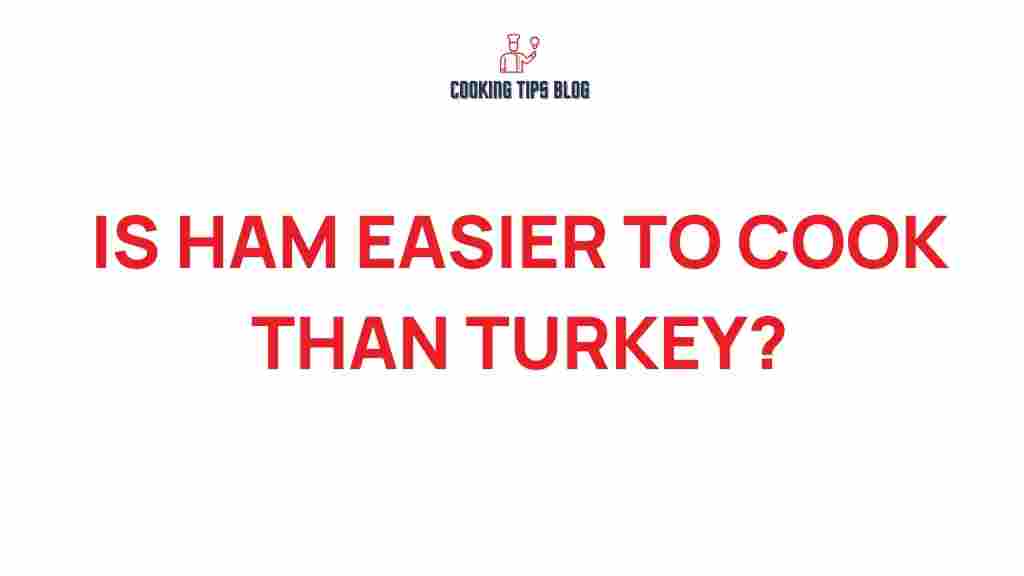Is Ham Really Easier to Cook Than Turkey? Unpacking the Myths
When it comes to holiday feasts, the age-old debate between ham and turkey often surfaces. With families gathering around the table, the pressure is on to deliver a delicious and satisfying meal. But is ham really easier to cook than turkey? In this article, we’ll unpack the myths surrounding both meats and determine whether ham deserves its reputation for being the simpler option.
The Basics: Understanding Ham and Turkey
Before diving into cooking techniques, let’s clarify what we mean by ham and turkey. Ham refers to the cured or smoked meat from a pig’s hind leg, while turkey is a large bird often associated with Thanksgiving and other festive occasions. Each meat comes with its own set of preparation and cooking methods, which can influence the perceived difficulty of cooking them.
Why Many Believe Ham is Easier to Cook
The perception that ham is easier to cook than turkey can be attributed to several factors:
- Pre-cooked Options: Most hams available in stores are pre-cooked or cured, which means they require less prep work. In contrast, turkey often needs more time and attention during preparation.
- Shorter Cooking Times: Hams generally require less cooking time than turkeys, which can take several hours to roast properly.
- Less Risk of Dryness: With careful cooking, ham tends to retain its moisture better than turkey, which can easily dry out if overcooked.
Step-by-Step Cooking Ham
Now that we’ve outlined some reasons why people might find ham easier to cook, let’s delve into the actual cooking process.
Preparation Steps
- Select the Right Ham: Choose between a whole ham, half ham, or pre-sliced ham. Pre-sliced options are the easiest for beginners.
- Preheat Your Oven: For most hams, an oven temperature of 325°F (165°C) is ideal.
- Glazing (Optional): If you wish to add a glaze, prepare it using ingredients like brown sugar, honey, and mustard. Apply the glaze to the ham during the last 30-45 minutes of cooking.
Cooking Steps
- Place the Ham in a Roasting Pan: Use a shallow pan to allow for even cooking.
- Add Liquid: Pour a cup of water or broth into the bottom of the pan to create steam and keep the ham moist.
- Cover with Foil: Tightly cover the ham with aluminum foil to retain moisture.
- Cook: Bake according to the weight of the ham (typically 15-18 minutes per pound). Use a meat thermometer to ensure it reaches an internal temperature of 140°F (60°C).
- Glaze and Brown: Remove the foil during the last 30 minutes, brush on the glaze, and return to the oven until caramelized.
Step-by-Step Cooking Turkey
Now let’s compare this with the steps to cook a turkey, highlighting where the challenges may arise.
Preparation Steps
- Select the Right Turkey: Choose a fresh or frozen turkey (thawing takes time if frozen).
- Brining (Optional): Brining can enhance flavor and moisture but requires planning and time.
- Preheat Your Oven: Set your oven to 325°F (165°C).
Cooking Steps
- Prepare the Turkey: Remove the giblets and pat the turkey dry. Season inside and out.
- Stuffing (Optional): If you’re using stuffing, make sure it’s cooked to a safe temperature.
- Place in a Roasting Pan: Use a deep roasting pan to accommodate the juices.
- Cover with Foil: Cover the breast with foil to prevent over-browning.
- Cook: Roast the turkey for about 13-15 minutes per pound, checking the internal temperature of the thickest part of the thigh (should reach 165°F or 74°C).
- Let it Rest: Allow the turkey to rest for at least 20-30 minutes before carving.
Common Troubleshooting Tips
Both ham and turkey have their fair share of potential pitfalls. Here are some troubleshooting tips for each:
Ham Troubleshooting
- Dry Ham: If your ham turns out dry, it may have cooked too long. Always monitor the internal temperature closely.
- Overly Salty: Some hams can be overly salty due to curing. A soaking method before cooking can help reduce saltiness.
Turkey Troubleshooting
- Dry Turkey: Avoid overcooking by using a meat thermometer and checking the temperature frequently.
- Uneven Cooking: If the turkey cooks unevenly, consider tenting with foil, especially for the breast.
Conclusion: Ham vs. Turkey
So, is ham really easier to cook than turkey? The answer largely depends on personal experience, preferences, and the specific recipes used. While ham may have an edge in terms of convenience—thanks to pre-cooked options and shorter cooking times—turkey can offer a more traditional and flavorful experience when cooked correctly.
Ultimately, whether you choose ham or turkey for your next holiday feast, both meats can be delicious and satisfying when prepared with care. For more cooking tips and techniques, check out this comprehensive guide on cooking meats to perfection!
So, which will it be for your next festive gathering? The ease of ham or the challenge of a perfectly roasted turkey? Happy cooking!
This article is in the category Recipes and created by Cookingtipsblog Team
